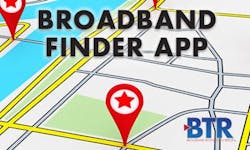"It is a matter of not just fiber availability or LTE availability, but it is a converged package of connectivity that customers are seeking," said Brian Mefford, CEO of Connected Nation Exchange. "If you think about a company evaluating a particular location, they want to verify that fiber is going to be available in a redundant manner ... LTE service is viable, and (that there are options for a) fixed wireless solution as well so they can come inside the building and have strong advanced WiFi and machine-to-machine connectivity."
The problem is that unlike the other utilities, information about the communications infrastructure hasn't always been the easiest to uncover. Enter Connected Nation Exchange. Mefford's company works with states and cities to organize and aggregate publically and privately owned assets for the purpose of supporting broadband-based expansion and job creation. The objective is to map the entire country, but efforts are being prioritized in the locations that have expressed an interest.
For example, the state of Michigan recently contracted for an application to help businesses locate the fastest digital infrastructure. The app provides a list of broadband providers that have fiber-optic networks within a quarter-mile of a considered property, those with broadband service of 100 Mbps or faster, and those with fiber-optic networks in a particular city.
While the end result benefits businesses seeking an advanced communication infrastructure by making their choices more readily available, service providers stand to benefit, too. In a competitive situation, it may seem logical to keep information on assets close to the vest. But what if the answer to gaining more business, making better strategic decisions and improved service to customers lies in sharing data it might seem intuitive to protect?
"There tends to be some reticence any time this information is being made more publically available," Mefford said. "Once carriers see the intention is to add to their customer base, then positions change and soften on making the information available. That is the purpose ... to bring customers, who these companies might not otherwise know are searching for service, to them."
"There tends to be more fiber underground or overhead than most people realize," Mefford added. "That becomes very helpful in uncovering that previously unknown or little known asset. If a company or carrier can access dark fiber that they didn't know about or didn't know was available for use, it can lower costs significantly."
Connected Nation is mapping not just fiber, but also vertical assets, including rooftops and towers as well as utility and traffic poles. In effect, bundles of assets are being presented to service providers seeking to expand their networks.
"We are able to uncover assets that previously may have been unknown or viewed as inaccessible. We can help change the math for their investment decisions in a particular location," Mefford said.
